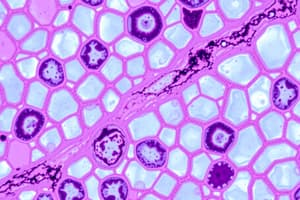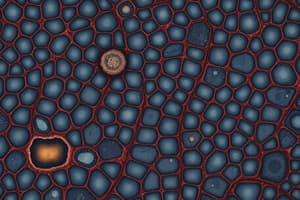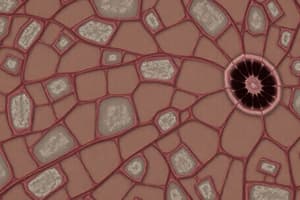Podcast
Questions and Answers
What is a defining characteristic of epithelial tissue?
What is a defining characteristic of epithelial tissue?
- Lacks regenerative ability
- Contains blood vessels (correct)
- Is predominantly made of adipose cells
- Has minimal intercellular spaces (correct)
Which type of epithelium is primarily involved in secretion?
Which type of epithelium is primarily involved in secretion?
- Simple columnar epithelium
- Simple cuboidal epithelium (correct)
- Simple squamous epithelium
- Pseudostratified columnar epithelium
What type of epithelial cell appears layered but all cells contact the basement membrane?
What type of epithelial cell appears layered but all cells contact the basement membrane?
- Simple squamous epithelium
- Pseudostratified columnar epithelium (correct)
- Simple cuboidal epithelium
- Simple columnar epithelium
Which of the following epithelium types is important for gas exchange?
Which of the following epithelium types is important for gas exchange?
Which characteristic does NOT apply to epithelial tissue?
Which characteristic does NOT apply to epithelial tissue?
What characterizes pseudostratified columnar epithelium?
What characterizes pseudostratified columnar epithelium?
Which type of epithelium is found in the urinary bladder?
Which type of epithelium is found in the urinary bladder?
What is the primary function of simple squamous epithelium?
What is the primary function of simple squamous epithelium?
Which epithelium type has cilia that aid in moving mucus?
Which epithelium type has cilia that aid in moving mucus?
What distinguishes stratified squamous epithelium from simple squamous epithelium?
What distinguishes stratified squamous epithelium from simple squamous epithelium?
Where would you typically find simple cuboidal epithelium?
Where would you typically find simple cuboidal epithelium?
What role does transitional epithelium play in the body?
What role does transitional epithelium play in the body?
Which characteristic is NOT associated with simple columnar epithelium?
Which characteristic is NOT associated with simple columnar epithelium?
Flashcards are hidden until you start studying
Study Notes
Epithelial Tissue
- Developed from ectoderm, mesoderm, or endoderm.
- Sits on a basement membrane.
- Consists of closely packed cells with minimal space between them.
- Avascular (no blood vessels).
- Nerves pass between cells.
- Receives nourishment by diffusion from connective tissue.
- High regeneration power.
Epithelial Tissue Types
- Surface epithelium: Cells form a sheet, covering surfaces or lining cavities.
- Glandular epithelium: Cells secrete substances.
- Neuroepithelium: Cells receive sensations.
- Myoepithelium: Cells have contractile functions.
Surface Epithelium
- Simple epithelium: One layer of cells on a basement membrane.
- Simple squamous: One layer of flat cells.
- Simple cuboidal: One layer of cube-shaped cells.
- Simple columnar: One layer of tall cells.
- Pseudostratified columnar: Appears layered, but all cells actually contact the basement membrane.
- Stratified epithelium: Multiple layers of cells.
- Stratified squamous: Multiple layers of squamous cells.
- Transitional epithelium: Found in organs that need elasticity.
Epithelium Locations and Functions
- Pseudostratified columnar (ciliated and non-ciliated): Upper respiratory tract, vas deferens, male urethra.
- Functions: Protection, secretion, movement of mucus.
- Simple squamous: Blood vessels, heart, lungs, body cavities.
- Functions: Filtration, diffusion of gases, secretion.
- Simple cuboidal: Kidney tubules, thyroid follicles.
- Functions: Secretion, absorption.
- Simple columnar: Intestine, stomach, gallbladder.
- Functions: Secretion, absorption.
- Stratified squamous: Lining of the mouth, esophagus, vagina.
- Functions: Protection against abrasion and dehydration.
- Transitional epithelium: Urinary bladder, ureters, part of the urethra.
- Functions: Stretchability, resistance to pressure and chemical changes.
Additional Notes On Epithelial Tissue
- Pseudostratified columnar epithelium: Cells are all connected to the basement membrane, despite differing heights and nuclei locations, making it appear stratified.
- Transitional epithelium ("uroepithelium"): Cells can change shape and layers when stretched to allow for change in volume in organs such as the bladder.
Studying That Suits You
Use AI to generate personalized quizzes and flashcards to suit your learning preferences.




